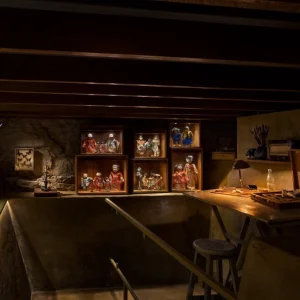Tate Modern
Herzog & de Meuron
London 2000
With more than 4.7m visitors a year, Tate Modern is the most successful gallery in the world – beating the 900,000 of New York’s Guggenheim and St Petersburg’s Hermitage with 2.5m. But less than 20 years ago, Bankside Power Station was slated for demolition, that is, until Tate announced it would house its new modern art gallery there. Tate director, Sir Nicholas Serota should be lauded for pulling off his greatest gamble in what seemed like an effortless process. The competition was announced in July 1994 and by the new year, Herzog & de Meuron were awarded the project. Five years later, in 2000, Tate Modern officially opened and became the architectural superstar of the new century.
When plans for the coal-fired Battersea Power Station were proposed in 1927, there was a cacophony of protest about the potential eyesore, as well as the possible harm that pollution could cause paintings in the nearby Tate Gallery. To placate the aesthetic criticism, Sir Giles Gilbert Scott was brought in to design the monumental building. Battersea has since transformed into an iconic landmark, with help from Pink Floyd and an inflatable pig. Scott also designed Bankside, a smaller, oil-fired station, which started operations in 1952.
By the early 1980s, both power stations had been decommissioned. While Battersea went on an Odyssean voyage of unrealised proposals, Bankside was able to benefit from another success story from the late 20th century. Emerging in 1988, the Young British Artists inspired an enduring public craze for contemporary art. The transformation of a power station into a temple of modern art reflects the wider impetus of the nation’s transition from an industrial to a services economy. As the first nation to kick-start the industrial revolution, it was fitting that the British cultural legacy created by its ‘new creative industries’ should have a power station as a paragon of the arts.
The transition in the economy means that there is a wealth of vacant industrial buildings awaiting new life. Similar reinventions include the Baltic, on Gateshead’s quayside, where a redundant grain warehouse was redeveloped into a centre for contemporary visual arts. There are even plans to convert a disused Gasometer at London’s King’s Cross into a flexible amenity space for the community.
Tate Modern is as good as building conversion gets. It has instigated the incredible transformation of the area south of the Thames into a cultural hub.
Herzog & de Meuron’s design provided the ideal balance between old and new. Unlike Nicholas Grimshaw, who wanted the building to stay exactly the same, or David Chipperfield’s proposal, which included lopping off the chimney, Herzog & de Meuron kept the shell of the building – its iconicity – while creating new gallery spaces in the old boiler house, capping it all off with a two-storey opaque lightbox.
It has been argued that the popularity of Tate Modern is due to it being the only modern art gallery of its size in London. This is undermined by the fact that, compared to similar attractions such as the Louvre and Bilbao’s Guggenheim, it has both a modest permanent collection and display area. Though the sacrifice of space to the Turbine Hall is felt in the more constricted galleries, the gesture was worth it. The Turbine Hall, with its enormous concourse in a muted colour palette and long strips of daylight, offers a contemplative space for each visitor to reflect after viewing the art. The planned extension, by Herzog & de Meuron, will deliver another 5,000 sq m of gallery space, alleviating the current congestion and further enhancing the Tate experience.






